To Repair, Modify Or View An Exchange Database At The Page Level, Which Tool Should You Use?
Lesson 1: Monitoring Exchange Databases
Database monitoring involves regularly checking the health of your databases. Typically, your monitoring procedures are complemented by a notification system that sends alerts to administrators when problems occur. You can use the Commutation Management Console (EMC) and the Substitution Management Crush (EMS) to obtain database information and statistics. Additional tools, such equally Microsoft Operations Director, tin can as well assist in monitoring your Commutation arrangement, just this chapter concentrates on the facilities provided straight past Microsoft Exchange Server 2010.
Microsoft recommends monitoring your databases on a daily basis. The main advantages to daily monitoring are as follows:
-
You can quickly detect and address issues that may affect the messaging service or information availability.
-
Y'all can ensure the successful completion of specific administrative tasks, such equally daily backup operations.
-
It helps you meet the requirements of your Service Level Agreements.
In this lesson, yous consider how you lot monitor public folder and mailbox database statistics to detect anomalies and indications of electric current and future bug and how you bank check the condition of an Exchange Server 2010 database. You also consider how you monitor status information nearly mailbox database copies included in a database availability group (DAG).
Monitoring Exchange Database Data and Statistics
In lodge to check the wellness of your Exchange databases and of the replication procedure (if configured), you need to monitor your databases. You can obtain general information almost both public folder and mailbox databases and statistics related to the public folders and mailboxes they contain. You can obtain more specific information about mailboxes and mailbox databases, such equally usage information, information virtually queues, information nigh lagged mailbox database copies, and information near disconnected mailboxes.
Obtaining Information well-nigh Mailbox Databases
When you are monitoring a mailbox database you first need to obtain general data about the database, such every bit the server where it is located, its mailbox retentiveness catamenia, deleted particular retention period, quota limits, associated public binder database, and and then on. Yous can use the Get-MailboxDatabase cmdlet to obtain general information for mailbox databases. For example, the following command returns detailed information most all the mailbox databases in an Exchange 2010 organization:
Get-MailboxDatabase | FL
The previous command typically returns a lot of information that you would probable redirect into a text file for analysis. In a big organization that has a lot of databases, this command returns an excessive volume of data. You lot have the option of refining this information by specifying the Mailbox server, the mailbox database identity, or both. For case, the post-obit command returns detailed information about the mailbox database named Mailbox Database 1363123687:
Become-MailboxDatabase -Identity "Mailbox Database 1363123687" | FL
Effigy ix-1 shows some of the output from this command.
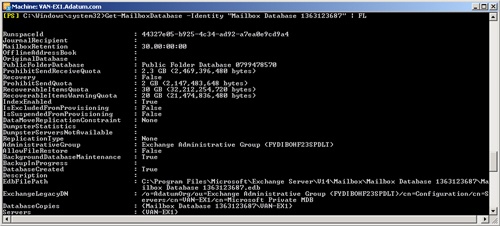
Figure 9-i Detailed information most a mailbox database
The ship dumpster is described in Chapter 8, "Configuring Transport Servers." You can obtain statistics (if bachelor) most the ship dumpster, such as dumpster deletes per second, dumpster inserts per 2nd, and dumpster detail count past including the DumpsterStatistics parameter, as demonstrated past the following command:
Get-MailboxDatabase -Identity "Mailbox Database 1363123687" -DumpsterStatistics | FL
Yous tin also determine the status of the mailbox database, if this is available, by including the Status parameter. This tells you lot whether the status of the mailbox database is one of the following: BackupInProgress, Mounted, or OnlineMaintenanceInProgress. It also tells y'all the available free space in the database root. Checking the status of mailbox databases is an of import pace in monitoring replication wellness. The following control uses the Status parameter:
Go-MailboxDatabase -Identity "Mailbox Database 1363123687" -Status | FL
You can besides utilize the EMC to decide the properties of a mailbox database. The procedure is as follows:
-
On your Mailbox server, open the EMC.
-
Click Mailbox nether Organization Configuration in the Console tree.
-
In the Upshot pane, click the Database Management tab and then click the mailbox database whose condition y'all want to decide.
-
Click Properties in the Actions pane.
The tabs on a mailbox database Properties dialog box are General, Maintenance, Limits, and Client Settings, equally shown in Figure 9-2. The data available on these tabs was discussed in detail in Affiliate two, "Substitution Databases and Address Lists."
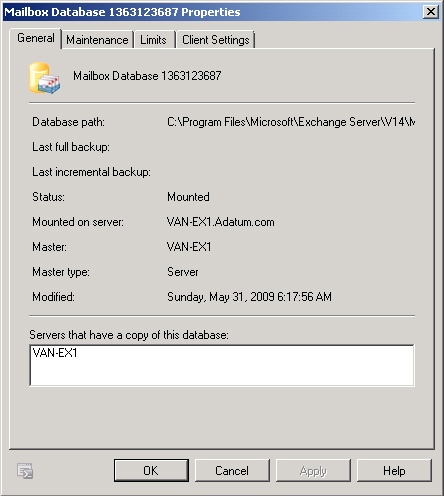
Figure 9-ii A mailbox database Backdrop dialog box
Viewing Mailbox Statistics
You can use the Get-MailboxStatistics EMS cmdlet to view the statistics for all the mailboxes on a server, for all the mailboxes in a mailbox database, or for a single mailbox. Note that you cannot use the cmdlet without arguments to view the statistics for all mailboxes in an Exchange organisation. The cmdlet requires the Server, the Database, or the Identity parameter.
For example, the post-obit command lists the statistics for all the mailboxes on the VAN-EX1 Mailbox server:
Go-MailboxStatistics -Server VAN-EX1 | FL
The following command lists the statistics for all the mailboxes in the mailbox database Mailbox Database 1363123687:
Get-MailboxStatistics -Database "Mailbox Database 1363123687" | FL
Figure nine-3 shows the output from this control.
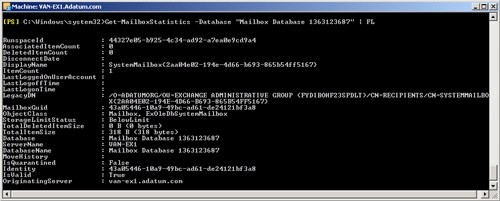
Figure 9-iii Viewing the statistics for mailboxes in a mailbox database
If a user mailbox has been created but has never been accessed, that mailbox is not included when you list the statistics of mailboxes on a server or in a mailbox database. If you attempt to obtain statistics for a mailbox that has not been accessed, you will get no statistical information only will instead receive a alert message. Suppose, for example, that the Don Hall mailbox has never been accessed and you enter the following command:
Get-MailboxStatistics -Identity "Don Hall" | FL
This results in the message shown in Figure 9-iv.

Figure 9-4 A mailbox needs to take been accessed before it will return statistics
If a mailbox returns statistics, yous tin apply the PowerShell format-list (FL) cmdlet to display the value of one or more specified statistics. This is more convenient than searching through the list of all the statistical values. For example, the following command displays the last logon time for the Kim Akers mailbox:
Get-MailboxStatistics -Identity "Kim Akers" | FL LastLogonTime
You can use the Sort-Object PowerShell cmdlet to sort the mailboxes in a mailbox database or on a Mailbox server by the value of one or more mailbox statistics. You can do this in either descending or ascending order and use the format-tabular array (FT) PowerShell cmdlet to display the results equally a table. For example, the following command lists the mailboxes in the Research mailbox database in descending society of particular count:
Get-MailboxStatistics -Database Research | Sort-Object ItemCount -Descending | FT DisplayName,ItemCount
The post-obit command lists the mailboxes in the Research mailbox database in descending gild of total item size:
Become-MailboxStatistics -Database Research | Sort-Object TotalItemSize -Descending | FT DisplayName,TotalItemSize
If you lot do not want to list all the mailboxes in a mailbox database or on a Mailbox server but instead desire to list, for example, the top five mailboxes in terms of total item size, you can pipe the results of your search into the Select-Object PowerShell cmdlet. For example, the post-obit command lists the top five mailboxes in Mailbox Database 1363123687 in descending society of total item size:
Get-MailboxStatistics -Database "Mailbox Database 1363123687" | Sort-Object TotalItemSize -Descending | Select-Object -First 5 | FT DisplayName,TotalItemSize
The following control lists the top ten mailboxes on the Mailbox server VAN-EX1 in descending lodge of detail count:
Become-MailboxStatistics -Server VAN-EX1 | Sort-Object ItemCount -Descending | Select- Object -First 10 | FT DisplayName,ItemCount
Monitoring Resource Usage
Sometimes pressure level on a mailbox database tin be the consequence of sure users consuming a disproportionate amount of resource, such as by sending an excessive number of large attachments to a big number of recipients. To observe this state of affairs, you tin use the Get-StoreUsageStatistics European monetary system cmdlet to generate a study on the 25 accounts that are using the greatest amount of resource inside a mailbox database. For example, the following command returns the 25 users with the largest mailboxes in Mailbox Database 1363123687:
Get-StoreUsageStatistics -Database "Mailbox Database 1363123687"
Yous tin also utilise the Get-StoreUsageStatistics cmdlet to obtain statistics about a specific mailbox, merely only if this mailbox account is ane of the 25 tiptop resource users. Under these circumstances, the following command would generate a report near the Kim Akers account:
Become-StoreUsageStatistics -Identity "Kim Akers"
Using Performance Monitor Counters
You can use the Exchange Server Performance Monitor tool to monitor counters that tin can bespeak whether resource in your Substitution arrangement are coming under stress. This is the aforementioned tool as Functioning Monitor (PerfMon) except that the Performance and Logs Alerts snap-in has been prepopulated with a large number of Exchange-related performance counters. You can access Exchange Server Operation Monitor from the EMC by clicking the Toolbox node, clicking Functioning Monitor, and clicking Open up Tool.
As an experienced administrator, yous should have used PerfMon on both server and client operating systems to monitor current operation, create data records, and generate reports. The tool provided past Substitution Server 2010 works in the same style, but you take the option of monitoring performance counters specific to Exchange. More than 100 MSExchange countergroups be, each one of which offers a significant number of counters.
You are not expected to be familiar with every counter that populates the Exchange Server PerfMon. It is probable that no single person could listing and draw all of them. Nor can you be expected to know the acceptable values that every counter returns. Although some countervalues be that definitely point a fault while other values bespeak that a process is operating in a satisfactory manner, absolute good or bad values are not typical. If you want to employ PerfMon counters to monitor performance, you would normally tape baseline counter values when your Exchange organization is working in a satisfactory manner—possibly during a quiet menstruation, under normal conditions, and during busy times. Recording values on a regular basis under the same conditions and comparing these to baseline values would indicate whether functioning is deteriorating over time and aid you track trends.
For example, to ensure that your mailbox databases continue to operate efficiently, you need to cheque that they are being defragmented online on an ongoing ground. Online defragmentation is a background task that operates continuously by default. Commutation Server 2010 provides the post-obit operation counters for monitoring the behavior of online database defragmentation:
-
MSExchange Database → Online Defrag Average Log Bytes Shows average size of the log records being generated by online defragmentation
-
MSExchange Database → Online Defrag Information Moves/Sec Shows the number of times that data is moved from one page to some other past the online defragmentation process
-
MSExchange Database → Online Defrag Log Records/Sec Shows the number of times per second that data is moved from one page to another by the online defragmentation process
-
MSExchange Database → Online Defrag Page Moves/Sec Shows the number of times that data is moved from one page to a new page by the online defragmentation process
-
MSExchange Database → Online Defrag Pages Dirtied/Sec Shows the rate at which online defragmentation is modifying clean database pages
-
MSExchange Database → Online Defrag Pages Freed/Sec Shows the number of pages per second that are freed from the database by the online defragmentation process
-
MSExchange Database → Online Defrag Pages Preread/Sec Shows the rate at which database pages are read in anticipation of future use by online defragmentation
-
MSExchange Database → Online Defrag Pages Read/Sec Shows the charge per unit of database read operations being performed by online defragmentation
-
MSExchange Database → Online Defrag Pages Re-Dirtied/Sec Shows the rate at which online defragmentation is modifying database pages that already contained modifications
-
MSExchange Database → Online Defrag Pages Referenced/Sec Shows the rate at which online defragmentation is touching database pages
Obtaining Data nearly Public Folder Databases
When you lot are monitoring a public folder database, you first need to obtain general information about the database, such every bit the server where it is located, what public folders it contains, its maximum item size, quota limits, replication schedule, and so on. You can use Ems commands based on the Get-PublicFolderDatabase cmdlet for this purpose. For example, the post-obit control gets detailed data about every public folder database in an arrangement:
Go-PublicFolderDatabase | FL
Figure ix-5 shows some of the output from this command.
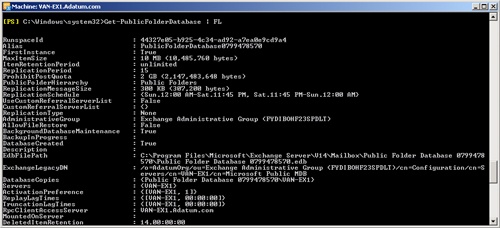
Figure ix-5 Detailed information about public binder databases
If you desire to obtain detailed data almost a specific public folder database, you can specify the Exchange Server 2010 Mailbox server on which it is located. For case, the post-obit control gets detailed information near the public folder database on the VAN-EX1 server.
Get-PublicFolderDatabase -Server VAN-EX1 | FL
It is typically easier to analyze and store this data if the output of the command is redirected to a text file. For example, the following command redirects detailed information most the public folder database on the VAN-EX1 server to the text file PublicFolderDetails .txt in the DatabaseInformation folder on the VAN-EX1 server:
Get-PublicFolderDatabase -Server VAN-EX1 | FL > C:\DatabaseInformation\PublicFolderDetails.txt
Y'all tin can utilise the Status parameter of the Get-PublicFolderDatabase cmdlet to obtain fill-in and mount status information (if bachelor). Checking the condition of public folder databases is an important step in monitoring replication health. The post-obit command gets detailed information near the public folder database on the VAN-EX1 server, including status data:
Get-PublicFolderDatabase -Server VAN-EX1 -Status | FL
You lot can use the EMC to obtain information near a public binder database. This information, such as database path, status, maintenance schedule, replication interval, storage limits, public folder referral information, and so on, is the same equally that returned by EMS commands based on the Get-PublicFolderDatabase cmdlet. It does non tell you virtually database usage or the size and number of the public folders within the database.
The procedure to view public folder database properties is very like to that for viewing mailbox database properties described earlier in this lesson. The procedure is as follows:
-
On your Mailbox server, open the EMC.
-
Click Mailbox under Organization Configuration in the Console tree.
-
In the Event pane, click the Database Direction tab and then click the public folder database whose status y'all want to determine.
-
Click Backdrop in the Actions pane.
-
The General, Replication, Limits, and Public Folder Referral tabs of the public folder database Properties dialog box, shown in Effigy 9-6, show the backdrop of the public folder database.
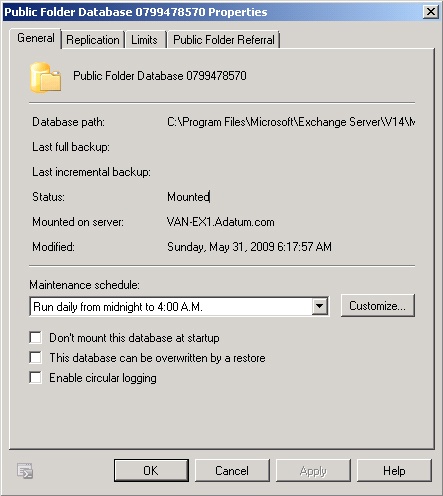
Effigy 9-6 The public folder database Backdrop dialog box
Viewing Public Folder Statistics
No EMS cmdlet exists that returns the statistics for an entire public folder database. However, you tin can employ the Get-PublicFolderStatistics Ems cmdlet to obtain statistics for each individual public folder inside a public binder database. You would, for case, obtain public folder statistics if you had created a new public folder database on another Mailbox server and you wanted to replicate a public folder on your current server to the new public folder database.
You can bank check replication by ensuring that, for example, the number and size of items in the public folder replica are the same as in the original public folder. You could use the aforementioned procedure if you replicate an entire public folder database and desire to cheque that replication is working correctly.
The following command obtains statistics for every public binder in an Exchange 2010 organisation:
Get-PublicFolderStatistics | FL
The previous command can render an excessive volume of information, particularly if you have a large number of public folders. As with mailbox databases, y'all can refine the information. If, for example, y'all desire to obtain statistics for every public folder in the public folder database on the Mailbox server VAN-EX1, you would enter the post-obit command:
Go-PublicFolderStatistics -Server VAN-EX1 | FL
If you want to obtain statistics for the public folder MyPublicFolder on the Mailbox server VAN-EX1, you would enter the following command:
Get-PublicFolderStatistics -Identity \MyPublicFolder -Server VAN-EX1 | FL
Figure nine-7 shows the output from this command. Note that this command runs only if you lot take previously created a public folder named MyPublicFolder every bit a child of the public folder root.
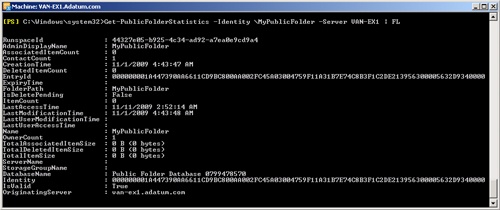
Figure 9-seven Statistics for the public folder MyPublicFolder
Detecting Database Errors
Database abuse occurs, for example, when the Substitution Server Database (EDB) file is damaged during improper server shut down, through virus infection, or because of physical harm to the storage media. If an entire Substitution database becomes corrupt, the ESE writes error messages to Event Viewer, such equally "Unable to read database header—database may take moved, or information was moved or was missing during recovery" or "Database page read failed verification considering of a 1018 fault (page checksum mismatch)." Yous can use tools such as Eseutil and Isinteg to repair a corrupt database or to prepare database integrity problems. However, Microsoft recommends restoring a corrupt database from backup considering the utilise of a tool such as Eseutil can lead to information loss. Chapter 14, "Exchange Disaster Recovery," discusses repairing a decadent database.
Sometimes a database is not itself corrupt but holds items such equally email messages, which are. Corrupt electronic mail messages can cause problems with mail period and lead to excessive queuing. If you lot move an Exchange database to another server or copy its contents to a new database, corrupt messages do not movement or copy. You lot can then delete such letters, typically with a not-commitment report (NDR).
Monitoring DAGs
A DAG is a set up of upwardly to 16 Substitution Server 2010 Mailbox servers that provide automated database-level recovery from the failure of a database, server, or network. DAGs use continuous replication and Windows failover clustering technologies to provide continuous mailbox availability. Mailbox servers in a DAG monitor each other for failures. When a Mailbox server is added to a DAG, information technology works with the other servers in the DAG to provide automatic, database-level recovery from database failures. Affiliate 13, "Exchange High-Availability Solutions," discusses DAGs in item. This lesson briefly discusses how y'all monitor the status information virtually mailbox database copies included in a DAG.
Exchange 2010 provides several built-in tools and features that are used for regular proactive monitoring when the Exchange arrangement is configured for high availability or site resilience through the creation of DAGs. The primary tools for monitoring mailbox database copies included in DAGs are the Ems cmdlets Go-MailboxDatabaseCopyStatus and Test-ReplicationHealth.
Exchange Server 2010 too introduces a new result log stream that uses the crimson aqueduct capabilities in Windows Server 2008 and Windows Server 2008 R2 and born scripts that can collect data from these effect channels.
Crimson Aqueduct Issue Logging
Applications and Services logs is a new category of event logs in Windows Server 2008 and Windows Server 2008 R2. Logs in this category shop events from a single application or component rather than events that have systemwide impact. The Applications and Services logs category includes four subtypes: Admin, Operational, Analytic, and Debug logs.
Typically, you would utilize event log records in the Admin logs subtype to troubleshoot bug. These events typically provide guidance about what action you lot should take when the consequence is logged. Events in the Operational log crave more than estimation. Analytic logs (hidden and disabled past default) shop events that trace an issue and, if enabled, typically log a high volume of events. Developers use Debug logs when debugging applications.
An awarding's scarlet channel contains result logs in the Applications and Services category that are specific to that detail application. Exchange Server 2010 has ii crimson channels: HighAvailability and MailboxDatabaseFailureItems. To view Exchange Server 2010 crimson channel outcome logs, deport out the following steps on the Exchange server:
-
Open up Event Viewer in the Administrative Tools carte.
-
Expand Applications and Services Logs in the Console tree. Expand Microsoft. Expand Commutation.
-
You should encounter two crimson channels under Substitution: High Availability and MailboxDatabaseFailureItems. Expand High Availability. This gives y'all access to the Debug and Operational logs. Effigy nine-eight shows the Operational log.
-
Expand MailboxDatabaseFailureItems. This gives you lot admission to the Operational log, shown in Effigy 9-9.
The MailboxDatabaseFailureItems channel logs events (including failure events) that affect a replicated mailbox database.
The High Availability channel contains events related to startup and shutdown of the Microsoft Substitution Replication service and the components that run inside that service, such equally Active Manager, the 3rd Party Synchronous Replication Awarding Plan Interface (API), the Tasks Remote Procedure Call (RPC) Server, Tcp Listener, and Volume Shadow Re-create Service writer. Active Manager uses this channel to log events related to Agile Manager part monitoring and database action events, such every bit a database mount operation and log truncation, and to tape events related to the DAG'south underlying cluster.
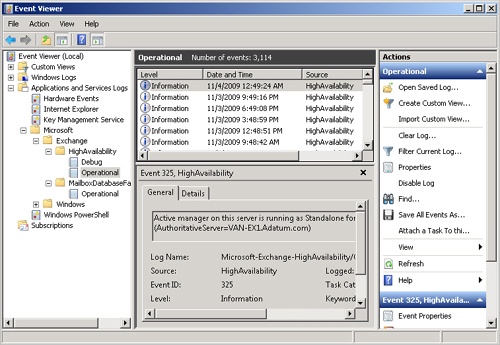
Figure 9-viii The HighAvailability Operational log
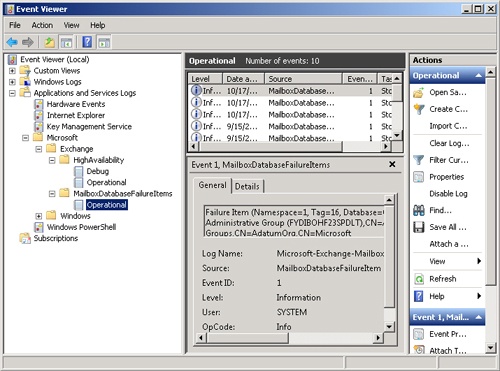
Effigy nine-9 The MailboxDatabaseFailureItems Operational log
Obtaining the Status of Mailbox Database Copies
When you are investigating the condition of your mailbox database copies, you typically need to determine whether the status of a particular database copy is, for example, failed or healthy. Yous tin can use the Get-MailboxDatabaseCopyStatus EMS cmdlet to view status data near mailbox database copies. This lets you lot obtain information about all copies of a database, data nigh a specific copy of a database on a specific server, or data well-nigh all database copies on a specific server.
For instance, the post-obit command returns status information for all copies of a mailbox database copy named MyMailboxDatabase in an Commutation Server 2010 organization:
Get-MailboxDatabaseCopyStatus -Identity MyMailboxDatabase | FL
Note that commands based on the Get-MailboxDatabaseCopyStatus cmdlet also return information about mailbox databases on a server if mailbox database copies are not implemented. However, the status information for a mailbox database returns fewer possible values than that for a mailbox database copy. For instance, a mailbox database that is not a copy cannot have the status "seeding."
The following command returns the condition for all mailbox database copies (and mailbox databases) on a Mailbox server named VAN-EX1:
Get-MailboxDatabaseCopyStatus -Server VAN-EX1 | FL
Figure 9-10 shows some of the output of this control.
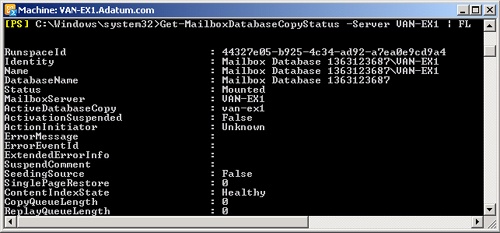
Figure 9-10 Status information for a mailbox database on server VAN-EX1
The post-obit command returns the status for all mailbox database copies on the Mailbox server on which the control is entered:
Get-MailboxDatabaseCopyStatus -Local | FL
The following command returns the status and log shipping and seeding network information for a mailbox database copy named MyMailboxDatabase on a Mailbox server named VAN-EX1 (log shipping and seeding information for a mailbox database copy are discussed in detail in Chapter 13):
Get-MailboxDatabaseCopyStatus -Identity MyMailboxDatabase\VAN-EX1 -ConnectionStatus | FL
Table 9-1 lists and describes possible values for the copy status of a mailbox database copy.
Table 9-one Mailbox database copy status
| Re-create STATUS | Description |
| ActivationSuspended | An administrator has manually blocked the mailbox database copy from activation. |
| DisconnectedAndHealthy | The mailbox database copy is no longer connected to the agile database copy and was in the Healthy state when the loss of connection occurred. This status represents the database copy's view of connectivity to its source database copy. It may exist reported during DAG network failures betwixt the source re-create and the target database copy. |
| DisconnectedAndResynchronizing | The mailbox database re-create is no longer connected to the active database re-create and was in the Resynchronizing state when the loss of connexion occurred. This status represents the database copy's view of connectivity to its source database copy. It may exist reported during DAG network failures between the source copy and the target database copy. |
| Dismounted | Just the agile copy of a mailbox database copy can have a copy condition of Dismounted. In this state, the active copy is offline and not accepting client connections. |
| Dismounting | Only the agile copy of a mailbox database copy can have a re-create status of Dismounting. In this state, the agile copy is going offline and terminating client connections. |
| Failed | The mailbox database copy is in a Failed state and cannot copy or replay log files. While the database copy is in a failed country and not suspended, the system will periodically check to see if the trouble that caused the failed copy status has been resolved. If the system detects that the problem has been resolved and no other problems are causing the database copy to fail, the re-create status automatically changes to Healthy. |
| FailedAndSuspended | The Failed and Suspended states have been gear up simultaneously by the system because a failure was detected, the resolution of which explicitly requires administrator intervention, such equally if the organisation detects unrecoverable divergence between the active mailbox database and a database copy. Unlike when the mailbox database copy condition is Failed, the arrangement does non periodically cheque to see if the problem has been resolved. Instead, an administrator must arbitrate to resolve the underlying cause of the failure before the mailbox database copy tin be transitioned to a Salubrious state. |
| Salubrious | The mailbox database copy is successfully copying and replaying log files, or it has successfully copied and replayed all available log files. |
| Initializing | The mailbox database re-create status is set every bit Initializing when a new database copy has been created, when the Microsoft Exchange Replication service is starting up or has just been started, and during transitions from Suspended, ServiceDown, Failed, Seeding, SinglePageRestore, LostWrite, or Asunder to another status. While a mailbox database copy is fix to the Initializing status, the organisation is verifying that the database and log stream are in a consistent state. In well-nigh cases, the Initializing mailbox database copy status will concluding for about 15 seconds, just in all cases, this status should not last for more than 30 seconds. |
| Mounted | But the active copy of a mailbox database re-create can accept a copy condition of Mounted. In this state, the active re-create is online and accepting client connections. |
| Mounting | Just the active copy of a mailbox database copy can have a copy status of Mounting. In this state, the agile re-create is coming online and non even so accepting client connections. |
| Resynchronizing | The mailbox database copy and its log files are being compared with the active copy of the database to cheque for whatever divergence between the two copies. The mailbox database re-create condition volition remain as Resynchronizing until any divergence is detected and resolved. |
| Seeding | The mailbox database re-create is being seeded, the content index for the mailbox database copy is being seeded, or both. Afterward seeding has successfully completed, the copy status changes to Initializing. |
| SeedingSource | In Exchange Server 2010, any salubrious database or database copy tin can exist used as the seeding source for an additional copy of that database. When a database is being used as a seeding source, its copy status is SeedingSource. |
| ServiceDown | The Microsoft Exchange Replication service is not running on the server that hosts the mailbox database copy. |
| SinglePageRestore | A single page restore operation is occurring on the mailbox database re-create. |
| Suspended | The mailbox database copy is in a Suspended land. You tin can manually suspend a database re-create past inbound a command based on the SuspendMailboxDatabaseCopy EMS cmdlet. |
Viewing the Continuous Replication Status of Mailbox Database Copies
If you lot demand to check all aspects of the replication and replay status of mailbox database copies and obtain a complete overview of replication on a specific Mailbox server in a DAG, you lot tin can use commands based on the Test-ReplicationHealth European monetary system cmdlet. This functionality implements proactive monitoring of continuous replication and the continuous replication pipeline. It indicates the availability of Agile Manager and the health and status of the underlying cluster service, quorum, and network components. You lot tin run the commands locally on or remotely against any Mailbox server in a DAG.
For example, the following tests replication health for the Mailbox server VAN-EX1:
Test-ReplicationHealth -Identity VAN-EX1 | FL
Figure 9-11 shows the output from this command.
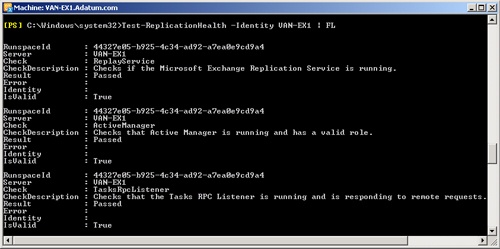
Figure ix-11 Testing replication health on Mailbox server VAN-EX1
The Test-ReplicationHealth cmdlet supports the OutputObjects parameter, which enables a command that uses this cmdlet to output an array of information regarding failures. The data returned tin can include the post-obit:
-
ServerName The server on which a failure occurs
-
CheckID A unique identifier for every check performed
-
CheckTitle The title of the check that was run
-
InstanceIdentity A unique string identifying the instance that failed (for example, a database Global Unique Identifier [GUID])
-
DbFailureEventID The Event identity (ID) of the failure event logged by the Microsoft Exchange Replication Service for a database copy that is in a Failed state
-
CheckResult A cheque issue (for example, pass, fail, or warning)
-
ErrorMessage A failure message logged by the check for the specific failure case
For example, the post-obit command tests replication health on server VAN-EX1 and returns failure information:
Test-ReplicationHealth -Identity VAN-EX1 -OutputObjects | FL
Figure 9-12 shows the output from this control. Note that if no failure has occurred, then no failure data is recorded.
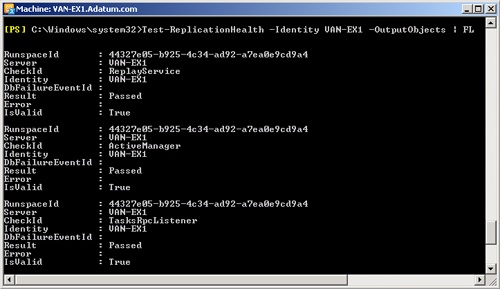
Figure 9-12 Using the OutputObjects parameter with the Test-ReplicationHealth cmdlet
Table ix-two lists and describes the tests you tin can perform past using the Examination-ReplicationHealth cmdlet.
Tabular array ix-2 Continuous replication status tests
| TEST | DESCRIPTION |
| ActiveManager | Verifies that the case of Active Director running on the specified DAG fellow member (or, if no DAG fellow member is specified, on the local server) is in a valid role (Primary, Secondary, or Standalone). |
| ClusterNetwork | Verifies that all cluster-managed networks on the specified DAG fellow member (or, if no DAG member is specified, on the local server) are available. |
| ClusterService | Verifies that the Cluster service is running and can exist reached on the specified DAG member. If no DAG member is specified, this tests if the service is reachable on the local server. |
| DagMembersUp | Verifies that all DAG members are upwardly and running and reachable. |
| DBCopyFailed | Checks whether any mailbox database copies are in a Failed state on the specified DAG member or, if no DAG member is specified, on the local server. |
| DBCopySuspended | Checks whether any mailbox database copies are in a Suspended country on the specified DAG fellow member or, if no DAG fellow member is specified, on the local server. |
| DBDisconnected | Checks whether whatever mailbox database copies are in a Disconnected state on the specified DAG fellow member or, if no DAG member is specified, on the local server. |
| DBInitializing | Checks whether any mailbox database copies are in an Initializing state on the specified DAG member or, if no DAG member is specified, on the local server. |
| DBLogCopyKeepingUp | Verifies that log copying and inspection past the passive copies of databases on the specified DAG member (or, if no DAG member is specified, on the local server) is able to keep up with log generation activity on the agile copy. |
| DBLogReplayKeepingUp | Verifies that replay activity for the passive copies of databases on the specified DAG member (or, if no DAG member is specified, on the local server) is able to continue up with log copying and inspection activity. |
| FileShareQuorum | Verifies that the witness server, witness directory, and share configured for the DAG are reachable. |
| QuorumGroup | Verifies that the default cluster group (quorum group) is in a healthy and online state. |
| ReplayService | Verifies that the Microsoft Commutation Replication service is running and tin can exist reached on the specified DAG fellow member, or if no DAG fellow member is specified, this tests if the service is reachable on the local server. |
| TasksRpcListener | Verifies that the tasks RPC server is running and reachable on the specified DAG member or, if no DAG member is specified, on the local server. |
| TcpListener | Verifies that the TCP log copy listener is running and reachable on the specified DAG member or, if no DAG member is specified, on the local server. |
Obtaining Switchover and Failover Statistics
If y'all are monitoring mailbox database copies, you sometimes need to monitor when switchovers or failovers occur and how frequently this is happening. Exchange Server 2010 provides the CollectOverMetrics.ps1 script. This collects data about switchover- and failover-related statistics that accept already been recorded. It is a passive monitoring script and does non generate whatever new statistics. The script supports parameters that enable you to customize the script'southward beliefs and output. For a total list of these parameters, refer to the More than Info link at the end of this section. Examples of the (arguably) more than significant parameters are equally follows:
-
DatabaseAvailabilityGroup The DAG from which you lot want to collect metrics. If this parameter is omitted, the local server'due south DAG is used.
-
Database One or more databases for which the report is generated. This parameter supports wildcards.
-
StartTime The time from which upshot data is collected. If this parameter is omitted, the showtime time is 12:00 AM on the preceding day.
-
EndTime The time at which event information collection stops. If this parameter is omitted, events are collected upwards to 11:59 PM on the preceding day.
-
IncludeAppLogs Specifies if events in the Application consequence log should also exist collected, merged, and candy. The following providers are included past default: MSExchangeIS, MSExchangeIS Mailbox Store, and MSExchangeRepl.
-
ShowHtmlReport Specifies that an HTML report should be displayed in a web browser afterward information technology is generated.
-
GenerateHtmlReport Specifies that the report should exist output in simple HTML tabular array format.
For instance, the following control collects metrics for all databases whose names commencement with MyData in the DAG named MyDAG and generates and displays an HTML report after the metrics are nerveless:
CollectOverMetrics.ps1 -DatabaseAvailabilityGroup MyDAG -Database:"MyData*" -GenerateHTMLReport -ShowHTMLReport
This control collects metrics for all databases in a DAG named SecondDAG and generates and displays an HTML report after the metrics are collected:
CollectOverMetrics.ps1 -DatabaseAvailabilityGroup SecondDAG -GenerateHTMLReport -ShowHTMLReport
Monitoring Replication Metrics
If you demand to collect and monitor metrics actively in real time, you can employ the Exchange Server 2010 CollectReplicationMetrics.ps1 script. The script supports parameters that enable y'all to customize its behavior and output. It does not have a StartTime or an EndTime parameter considering information technology starts immediately. Instead, you can specify a duration parameter. The script does not back up the ShowHTMLReport or GenerateHTMLReport parameters, but you can specify Verbose to brandish the script output on the screen.
For case, the following command collects metrics for all databases in the DAG named MyDAG and displays the collected data in an on-screen report:
CollectReplicationMetrics.ps1 -DagName MyDAG -Verbose
Every bit with the CollectOverMetrics.ps1 script, the CollectReplicationMetrics.ps1 script will non run if the server is not role of a DAG.
Lagged Mailbox Database Copies
A lagged mailbox database re-create is a passive mailbox database copy that has a log replay lag time greater than zero. You can create lagged mailbox database copies equally insurance against corruption caused by, for example, impairment to the EDB file during improper server shutdown. If you lot activate and recover a lagged mailbox database copy, the database replays all log files and makes the database re-create electric current. The database copy thus created replaces the corrupted database. If you desire to replay log files upwards to a specific point in time, you need to manually manipulate log files and run the Eseutil utility.
If you want to configure a lagged mailbox database copy of a mailbox database, you can use the Add-MailboxDatabaseCopy European monetary system cmdlet. If yous specify the SeedingPostponed parameter, the new copy remains in a Suspended country because the database needs to be seeded.
The ReplayLagTime parameter specifies the amount of time that the Microsoft Commutation Replication service waits earlier replaying log files that have been copied to the passive database copy. If you set this parameter to a value greater than zero, this creates a lagged database copy. The TruncationLagTime parameter specifies the corporeality of time that the Substitution Replication service waits earlier truncating log files that have replayed into the passive copy of the database. This fourth dimension menses begins after the log has been successfully replayed into the copy of the database.
If you want to configure a lagged mailbox database copy of the database Mailbox Database 1363123687 that is hosted on Mailbox server VAN-EX1 and you desire to configure a replay lag fourth dimension of 10 minutes and truncation lag fourth dimension of ii days, you would enter the following command:
Add-MailboxDatabaseCopy -Identity "Mailbox Database 1363123687" -MailboxServer VAN-EX1 -ReplayLagTime 00:10:00 -TruncationLagTime 02:00:00
If yous want to change the replay lag time for the lagged mailbox database copy Mailbox Database 1363123687 to a value of one hour, you lot would enter the post-obit command:
Set-MailboxDatabaseCopy -Identity "Mailbox Database 1363123687" -ReplayLagTime 00:01:00
Lesson Summary
-
You lot can use Ems commands based on the Get-PublicFolderDatabase and Go-PublicFolderStatistics cmdlets to monitor public folder databases.
-
You can use European monetary system commands based on the Go-MailboxDatabase and Get-MailboxStatistics cmdlets to monitor mailbox databases.
-
You can view the Crimson Aqueduct logs in Event Viewer or apply commands based on the Become-MailboxDatabaseCopyStatus EMS cmdlet to obtain the status of mailbox database copies.
Lesson Review
Yous can use the following questions to examination your noesis of the data in Lesson one, "Monitoring Exchange Databases." The questions are as well bachelor on the companion CD if y'all adopt to review them in electronic form.
-
You want to view detailed information, including backup and mount condition information, near the public folder database on the ContosoMail01 mailbox server. What EMS control do yous enter?
-
Get-PublicFolderDatabase –Identity ContosoMail01 | FL
-
Become-PublicFolderDatabase –Server ContosoMail01 | FL
-
Become-PublicFolderDatabase –Identity ContosoMail01 -Status | FL
-
Get-PublicFolderDatabase –Server ContosoMail01 -Status | FL
-
-
Yous want to observe whether the status of the mailbox database MyMailboxDatabase is BackupInProgress, Mounted, or OnlineMaintenanceInProgress. Y'all also want to find how much free space is available in the database root. What EMS command do you enter?
-
Become-MailboxDatabase -Identity MyMailboxDatabase –Condition | FL
-
Get-MailboxDatabase -Server MyMailboxDatabase –Condition | FL
-
Get-MailboxDatabase -Identity MyMailboxDatabase – DumpsterStatistics | FL
-
Get-MailboxDatabase -Server MyMailboxDatabase – DumpsterStatistics | FL
-
-
Y'all want to obtain statistics for the Jeff Hay mailbox in the mailbox database MyMailboxDatabase on the Mailbox server Mal01. Yous enter the following command:
Become-MailboxStatistics -Identity "Jeff Hay" | FL
Mailbox statistics are non returned, but instead you go a alert message. What is the probable reason for this?
-
You lot need to use the Server parameter and specify the value Mail01.
-
You demand to use the Database parameter and specify the value MyMailboxDatabase.
-
Jeff Hay has never logged on to his mailbox, and the mailbox has not been accessed in any other way (for instance, an electronic mail message has non been sent to information technology).
-
Yous need to use the Become-StoreUsageStatistics cmdlet, not the Go-MailboxStatistics cmdlet.
-
-
Which mailbox database re-create condition indicates that the mailbox database copy is no longer continued to the active database re-create and that information technology was in the Resynchronizing land when the loss of connection occurred?
-
DisconnectedAndResynchronizing
-
ActivationSuspended
-
Seeding
-
DisconnectedAndHealthy
-
-
Which Ems cmdlet tin can yous use to generate a report on the 25 accounts that are using the greatest corporeality of resources within a mailbox database?
-
Go-MailboxStatistics
-
Go-StoreUsageStatistics
-
Get-MailboxDatabase
-
Go-MailboxDatabaseCopyStatus
-
To Repair, Modify Or View An Exchange Database At The Page Level, Which Tool Should You Use?,
Source: https://www.microsoftpressstore.com/articles/article.aspx?p=2229242&seqNum=2
Posted by: kellyforist.blogspot.com


0 Response to "To Repair, Modify Or View An Exchange Database At The Page Level, Which Tool Should You Use?"
Post a Comment